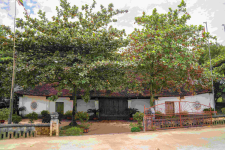
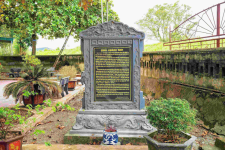
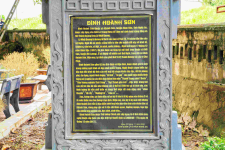
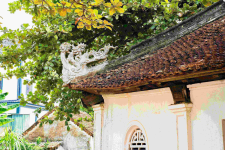
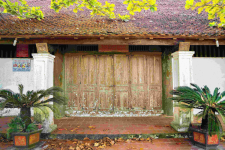
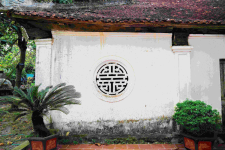
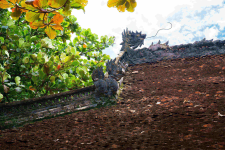
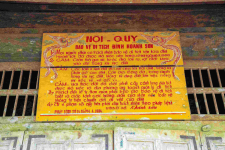
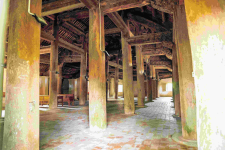
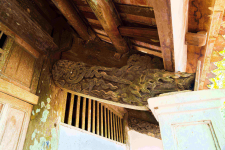
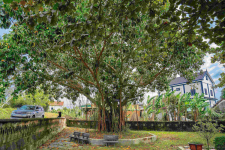

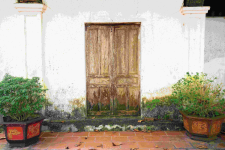
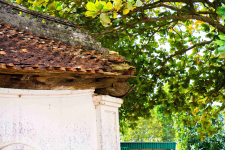
Camera tour
Price: Free
Time to visit a place: 120 phút
Open Time: 7:00 AM - Close Time: 6:00 PM
Address: Khanh Son Village, Nam Dan District, Nghe An Province
HOANH SON COMMUNAL HOUSE – NAM DAN DISTRICT
This is the first architectural and artistic relic of Nghe An province to be classified as a special national monument by the Prime Minister in Decision No. 2082/QD-TTg on December 25, 2017.
Hoanh Son communal house was built in 1763, completed in 1764, on a flat land, facing the North, in front is the romantic Lam Giang stream, surrounded by dense population, lush fields, Behind, there is Ngang mountain in the Thien Nhan range as a solid support, which is a prime location according to the art of "feng shui”.
This is a large-scale architectural work, where the talents, enthusiasm and wishes of the ancient Nam Dan residents converge. The communal house is famous for having many intricate carvings and decorations on wood, expressing rich content and first-class aesthetics.
The initiator and owner of the construction of Hoanh Son communal house is Mr. Dang Thac belonging to a family of patriarchal lineage, having authority in the region, having passed the Huong tribute exam in the Le Canh Hung dynasty (1740 - 1746), serving as a mandarin and was ordained as "Quảng Nghĩa bá". Meeting a good year, the people's life was affluent, and all classes of scholars, farmers, workers and merchants in the village were doing well, he mobilized people to donate to build the village communal house. He himself also spent a lot of money and donated a beautiful garden to the communal house.
The communal house has an architectural structure in the shape of the letter "Dinh", including the following items: courtyard, great communal house and harem. The great communal house was built of ironwood, including 8 trusses, 7 compartments (including 2 decorated compartments). The truss structure is in the style of "short wooden-slats were stacked on top of each other". The column system includes: 32 round ironwood columns, in which: 12 columns 5m high, 45 cm diameter; 20 extra columns 4m high, 42cm in diameter. the systemof transverse beam and cross-arm includes: 26 transverse beams spread evenly on 2 roofs; 42 cross-arm and 8 girth rails… The structure of the communal house is especially solid, capable of resisting big storms and floods.
The interior of the communal house is arranged with many sophisticated artistic carvings, a combination of carving and canal, very rich in legends and scenes of folk life. Beams on both sides of the main door are carved with two Chinese sentences solemnly located on the image of bat and leaf, each with 5 words: on the left side " wealth - precious (luxury) - longevity (long life) - healthy - peaceful "; On the right side, " clean-handed & honest, don't exceed moderation; don't act in a private way; don't do bad things " with the meaning of Hoanh Son village with 5 wards and 4 cycles, all of them keep good manners and morals, with wealth, luxury, longevity, leisure, and peace. The reliefs are carved with two dragons adoring the moon, the fish in the form of a dragon, and the mother dragon and her baby dragon wrapped in tangerines. The structural type of ancient house architecture was carved the theme of "four sacred animals" (dragon, unicorn, turtle, phoenix) - each mascot has a different posture, a different facial expression (happiness, jubilation, indignation, anger). The wind leaf boards often touch the classic theme, such as: Thanh Thang welcomes Y Doan, Han Su moi Tu Hac... Many pieces are carved with folk scenes such as: honoring, mandarin's order, martial arts, boat racing... Above the transverse beam, which supports the roof on the right, is also decorated with animations about farmers, fishermen (Feng Shui painting with four pleasures), such as: plucking seedlings, transplanting, carrying seedlings, plowing, harrowing, catching fish, putting away hooves, people carrying goods to the market, children herding buffaloes sitting and playing, etc., expressing the philosophy of life imbued with the human spirit of the nation, and reflect the level of carving has reached the master level. The harem consists of 1 compartment, which is a place of worship.
French scholar Hippolyte Le Breton in the work "An Tinh Co Luc" when visiting and learning about the communal house must also say "I have never seen a temple as beautiful as this one, the most outstanding among the temples bearing the religious character of the Annamites"
The main character worshiped at the communal house was the main deity of Uy Minh Vuong village, Ly Nhat Quang - the first district chief of Nghe An, who had made great contributions to the economic and social development of Nghe in general and Nam Dan in particular. His career mark was also clearly shown through the reclamation, land opening, village establishment, construction of traffic and irrigation works in Nghe An province. Later, in the communal house, there were also some gods and Buddhas x from other temples and pagodas in the damaged area.
Every year, at the communal house, the people of Hoanh Son village hold the Ky Phuc festival in the sixth lunar month. This was a highly organized, large-scale folk festival imbued with the local national cultural identity. The festival brought all the gods in the village to the council in the communal house to make sacrifices, attracting thousands of people to attend. The festival had many interesting and fun games to help people forget the fatigue at work, increase love and attachment to the homeland, unite the village community, and join hands to build a warm, happy life.
Distance: 10.25 km
Distance: 10.27 km
Distance: 10.42 km
Distance: 10.85 km
Distance: 11.27 km
Distance: 11.63 km
Distance: 12.32 km
Distance: 12.44 km
Distance: 13.11 km
Distance: 13.30 km
Distance: 13.93 km
Distance: 13.93 km
Distance: 14.36 km
Distance: 14.66 km
Distance: 14.68 km
Distance: 8.07 km
Distance: 8.50 km
Distance: 8.57 km
Distance: 10.79 km
Distance: 11.77 km
Distance: 12.06 km
Distance: 12.56 km
Distance: 12.84 km
Distance: 13.83 km
Distance: 15.03 km
Distance: 15.33 km
Distance: 15.34 km
Distance: 15.43 km
Distance: 15.46 km
Distance: 15.86 km
Distance: 16.15 km
Distance: 16.29 km
Distance: 16.34 km
Distance: 0 m
Distance: 3.20 km
Distance: 5.71 km
Distance: 5.84 km
Distance: 5.91 km
Distance: 6.28 km
Distance: 6.56 km
Distance: 7 km
Distance: 7.05 km
Distance: 7.07 km
Distance: 7.10 km
Distance: 7.14 km
Distance: 7.19 km
Distance: 7.39 km
Distance: 7.65 km
Distance: 7.65 km
Distance: 14.72 km
Distance: 15.10 km
Distance: 15.19 km
Distance: 15.21 km
Distance: 15.21 km
Distance: 15.32 km
Distance: 15.58 km
Distance: 15.59 km
Distance: 15.70 km
Distance: 15.81 km
Distance: 15.81 km
Distance: 15.84 km
Distance: 15.93 km
Distance: 15.93 km
Distance: 15.97 km


